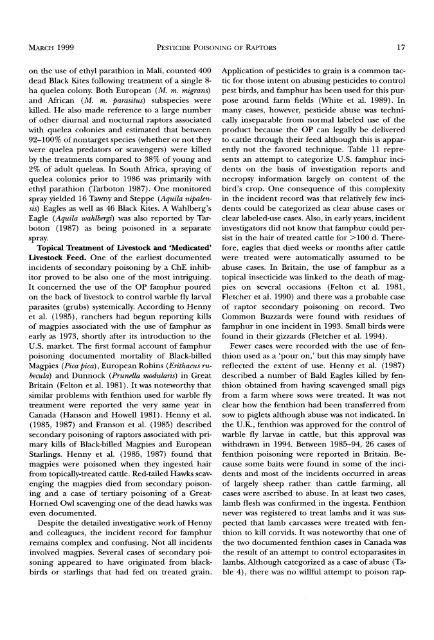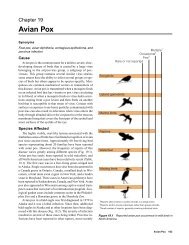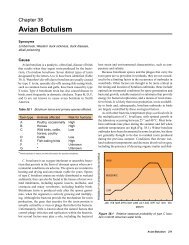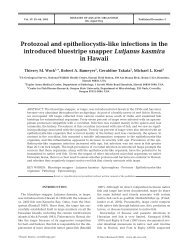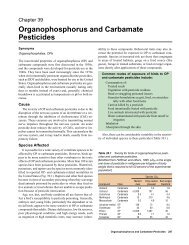poisoning of raptors with organophosphorus and carbamate ...
poisoning of raptors with organophosphorus and carbamate ...
poisoning of raptors with organophosphorus and carbamate ...
Create successful ePaper yourself
Turn your PDF publications into a flip-book with our unique Google optimized e-Paper software.
MA•CH 1999 PESTICIDE POISONING OF RAPTORS 17<br />
on the use <strong>of</strong> ethyl parathion in Mali, counted 400<br />
dead Black Kites following treatment <strong>of</strong> a single 8-<br />
ha quelea colony. Both European (M. m. migrans)<br />
<strong>and</strong> African (M. m. parasitus) subspecies were<br />
killed. He also made reference to a large number<br />
<strong>of</strong> other diurnal <strong>and</strong> nocturnal <strong>raptors</strong> associated<br />
<strong>with</strong> quelea colonies <strong>and</strong> estimated that between<br />
92-100% <strong>of</strong> nontarget species (whether or not they<br />
were quelea predators or scavengers) were killed<br />
by the treatments compared to 38% <strong>of</strong> young <strong>and</strong><br />
2% <strong>of</strong> adult queleas. In South Africa, spraying <strong>of</strong><br />
quelea colonies prior to 1986 was primarily <strong>with</strong><br />
ethyl parathion (Tarboton 1987). One monitored<br />
spray yielded 16 Tawny <strong>and</strong> Steppe (Aquila nipalensis)<br />
Eagles as well as 46 Black Kites. A Wahlberg's<br />
Eagle (Aquila wahlbergi) was also reported by Tarboton<br />
(1987) as being poisoned in a separate<br />
spray.<br />
Topical Treatment <strong>of</strong> Livestock <strong>and</strong> 'Medicated'<br />
Livestock Feed. One <strong>of</strong> the earliest documented<br />
Despite the detailed investigative work <strong>of</strong> Henny<br />
<strong>and</strong> colleagues, the incident record for lamphut<br />
remains complex <strong>and</strong> confusing. Not all incidents<br />
involved magpies. Several cases <strong>of</strong> secondary <strong>poisoning</strong><br />
appeared to have originated from blackbirds<br />
or starlings that had fed on treated grain.<br />
Application <strong>of</strong> pesticides to grain is a common tactic<br />
for those intent on abusing pesticides to control<br />
pest birds, <strong>and</strong> famphur has been used for this purpose<br />
around farm fields (White et al. 1989). In<br />
many cases, however, pesticide abuse was technically<br />
inseparable from normal labeled use <strong>of</strong> the<br />
product because the OP can legally be delivered<br />
to cattle through their feed although this is apparently<br />
not the favored technique. Table 11 represents<br />
an attempt to categorize U.S. famphur incidents<br />
on the basis <strong>of</strong> investigation reports <strong>and</strong><br />
necropsy information largely on content <strong>of</strong> the<br />
bird's crop. One consequence <strong>of</strong> this complexity<br />
in the incident record was that relatively few incidents<br />
could be categorized as clear abuse cases or<br />
clear labeled-use cases. Also, in early years, incident<br />
investigators did not know that famphur could persist<br />
in the hair <strong>of</strong> treated cattle for >100 d. There-<br />
fore, eagles that died weeks or months after cattle<br />
were treated were automatically assumed to be<br />
abuse cases. In Britain, the use <strong>of</strong> famphur as a<br />
topical insecticide was linked to the death <strong>of</strong> magpies<br />
on several occasions (Felton et al. 1981,<br />
Fletcher et al. 1990) <strong>and</strong> there was a probable case<br />
<strong>of</strong> raptor secondary <strong>poisoning</strong> on record. Two<br />
Common Buzzards were found <strong>with</strong> residues <strong>of</strong><br />
incidents <strong>of</strong> secondary <strong>poisoning</strong> by a ChE inhibitor<br />
proved to be also one <strong>of</strong> the most intriguing.<br />
It concerned the use <strong>of</strong> the OP lamphut poured<br />
on the back <strong>of</strong> livestock to control warble fly larval<br />
parasites (grubs) systemically. According to Henny<br />
et al. (1985), ranchers had begun reporting kills<br />
<strong>of</strong> magpies associated <strong>with</strong> the use <strong>of</strong> lamphut as<br />
early as 1973, shortly after its introduction to the<br />
famphur in one incident in 1993. Small birds were<br />
found in their gizzards (Fletcher et al. 1994).<br />
U.S. market. The first formal account <strong>of</strong> lamphut Fewer cases were recorded <strong>with</strong> the use <strong>of</strong> fen<strong>poisoning</strong><br />
documented mortality <strong>of</strong> Black-billed<br />
Magpies (Pica pica), European Robins ( Erithacus rubecula)<br />
<strong>and</strong> Dunnock (Prunella modularis) in Great<br />
Britain (Felton et al. 1981). It was noteworthy that<br />
thion used as a 'pour on,' but this may simply have<br />
reflected the extent <strong>of</strong> use. Henny et al. (1987)<br />
described a number <strong>of</strong> Bald Eagles killed by fenthion<br />
obtained from having scavenged small pigs<br />
similar problems <strong>with</strong> fenthion used for warble fly from a farm where sows were treated. It was not<br />
treatment were reported the very same year in clear how the fenthion had been transferred from<br />
Canada (Hanson <strong>and</strong> Howell 1981). Henny et el.<br />
(1985, 1987) <strong>and</strong> Franson et al. (1985) described<br />
secondary <strong>poisoning</strong> <strong>of</strong> <strong>raptors</strong> associated <strong>with</strong> primary<br />
kills <strong>of</strong> Black-billed Magpies <strong>and</strong> European<br />
Starlings. Henny et el. (1985, 1987) found that<br />
sow to piglets although abuse was not indicated. In<br />
the U.K., fenthion was approved for the control <strong>of</strong><br />
warble fly larvae in cattle, but this approval was<br />
<strong>with</strong>drawn in 1994. Between 1985-94, 26 cases <strong>of</strong><br />
fenthion <strong>poisoning</strong> were reported in Britain. Bemagpies<br />
were poisoned when they ingested hair cause some baits were found in some <strong>of</strong> the incifrom<br />
topically-treated catfie. Red-tailed Hawks scav- dents <strong>and</strong> most <strong>of</strong> the incidents occurred in areas<br />
enging the magpies died from secondary <strong>poisoning</strong><br />
<strong>and</strong> a case <strong>of</strong> tertiary <strong>poisoning</strong> <strong>of</strong> a Great-<br />
Horned Owl scavenging one <strong>of</strong> the dead hawks was<br />
even documented.<br />
<strong>of</strong> largely sheep rather than cattle farming, all<br />
cases were ascribed to abuse. In at least two cases,<br />
lamb flesh was confirmed in the ingesta. Fenthion<br />
never was registered to treat lambs <strong>and</strong> it was suspected<br />
that lamb carcasses were treated <strong>with</strong> fenthion<br />
to kill corvids. It was noteworthy that one <strong>of</strong><br />
the two documented fenthion cases in Canada was<br />
the result <strong>of</strong> an attempt to control ectoparasites in<br />
lambs. Although categorized as a case <strong>of</strong> abuse (Table<br />
4), there was no willful attempt to poison rap-


